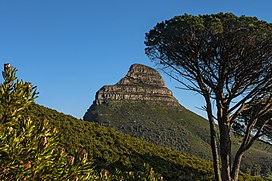geo.wikisort.org - Mountains
Lion's Head is a mountain in Cape Town, South Africa, between Table Mountain and Signal Hill. Lion's Head peaks at 669 metres (2,195 ft) above sea level. The peak forms part of a dramatic backdrop to the city of Cape Town and is part of the Table Mountain National Park.
| Lion's Head | |
|---|---|
 Lion's Head from the slopes of Table Mountain | |
| Highest point | |
| Elevation | 669 m (2,195 ft) |
| Coordinates | 33°56′05″S 18°23′21″E |
| Geography | |
| Location | Western Cape, South Africa |
| Geology | |
| Age of rock | Silurian / Ordovician |
| Climbing | |
| Easiest route | Hike |
Surrounding


The suburbs of the city surround the peak and Signal Hill on almost all sides, but strict management by city authorities has kept development of housing off the higher ground. The area is significant to the Cape Malay community, who historically lived in the Bo-Kaap quarter close to Lion's Head.
There are a number of historic graves and shrines (kramats) of Malay leaders on the lower slopes and on Signal Hill.
History
In the 17th century the peak was known as Leeuwen Kop (Lion's Head) by the Dutch, and Signal Hill was known as Leeuwen Staart (Lion's Tail), as the shape resembles a crouching lion or a sphinx. The English in the 17th Century called the peak Sugar Loaf.[1][2]
In 1897 gold was discovered on Lion's Head. A company was floated and a shaft sunk to a depth of more than 30 meters. However, the grade was too low, and the mine closed in the following year. Subsequently the shaft was filled in and a small depression is all that remains today.[3]
Activities
Lion's Head is known for its views of both the city and the Atlantic Seaboard, and the hour-long walk to the top is particularly popular during full moon.[1] Its slopes are also used as a launching point for paragliders.

Geology, flora and fauna
The upper part of the peak consists of flat-lying Table Mountain sandstone and the lower slopes are formed by the Cape Granite and the Malmesbury formation, which are older Precambrian rocks.
Lion's Head is covered in fynbos (indigenous Cape vegetation), with an unusually rich biodiversity that supports a variety of small animals. Three main vegetation types can be found in this relatively small area. All three of them are endemic to the city of Cape Town and can be found nowhere else. Most of Lion's Head is covered in endangered Granite Fynbos, which fades into Peninsula Shale Renosterveld (critically endangered) on the lower slopes towards Signal Hill in the north. Right on the summit of Lion's Head however, is a tiny patch of endangered Sandstone Fynbos, a different ecosystem that is also found nearby on the top of Table Mountain.[4] [5][6]
See also
- Signal Hill – Hill in Cape Town
- Table Mountain – Flat-topped mountain overlooking the city of Cape Town, South Africa
References
- "Lion's Head: Full Moon Hike". Cape Town Magazine. Retrieved 24 December 2006.
- Burman, Jose (1991). The Table Mountain Book. Human & Rousseau.
- Spargo, Peter (June 2015). "The Lion's Head Gold Mine". Bulletin of the National Library of South Africa. 69 (1). Retrieved 1 December 2019.
- "Cape Granite Fynbos. Cape Town Biodiversity Factsheets" (PDF).[permanent dead link]
- "Peninsula Shale Renosterveld. Cape Town Biodiversity Factsheets" (PDF).[permanent dead link]
- "Peninsula Sandstone Fynbos. Cape Town Biodiversity Factsheets" (PDF).[permanent dead link]
External links
На других языках
[de] Lion’s Head
Der Lion’s Head (afrikaans: Leeukop), wörtlich übersetzt Löwenkopf, jedoch auf älteren deutschen Karten als Löwenberg bezeichnet, ist neben dem Tafelberg einer der Hausberge Kapstadts. Er ist mit 669 Metern Höhe zwar nicht so hoch wie der Tafelberg, auf Grund seiner Kegelform und exponierten Lage gilt er jedoch als einer der schönsten Aussichtsberge in der Tafelbucht.- [en] Lion's Head (Cape Town)
[es] Cabeza de León (Sudáfrica)
Cabeza de León (en afrikáans, Leeukop) es una montaña situada en Ciudad del Cabo, Sudáfrica, entre la Montaña de la Mesa y Signal Hill. Cabeza de León se encumbra a 669 m sobre el nivel del mar. El pico forma parte del dramático telón de fondo de la Ciudad del Cabo y es parte del parque nacional Montaña de la Mesa.[fr] Lion's Head
Lion's Head (en afrikaans : Leeukop, « tête de lion ») est un pic rocheux surplombant la ville du Cap, en Afrique du Sud. Cette formation géologique haute de 669 mètres doit son nom à sa forme caractéristique qui évoqua une tête de lion aux premiers colons néerlandais. Elle est l'un des sommets les moins élevés d'un massif comprenant également les collines de Signal Hill, Devil's Peak et la montagne de la Table, et qui se prolonge vers le cap de Bonne-Espérance par les collines de Constantiaberg, de Chapman's Peak et de Swartkop.[it] Testa di Leone
La Testa di Leone (Leeukop in afrikaans, Lion's Head in inglese) è un monte di Città del Capo in Sudafrica, situato tra la montagna della Tavola e la Signal Hill.[ru] Лайонс-Хед (гора)
Ла́йонс-Хед (Лиукоп)[2] (англ. Lion's Head, африк. Leeukop) — скала в Кейптауне. Расположена между горой Столовая и Сигнал-Хилл. Высота горы — 670 м.Другой контент может иметь иную лицензию. Перед использованием материалов сайта WikiSort.org внимательно изучите правила лицензирования конкретных элементов наполнения сайта.
WikiSort.org - проект по пересортировке и дополнению контента Википедии